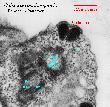 The cells are uninucleate.
There is a single Golgi body anterior to the nucleus and near the
flagellar bases. About five
sausage-shaped mitochondria are present; as in other stramenopiles, the
cristae are tubular.
The cells are uninucleate.
There is a single Golgi body anterior to the nucleus and near the
flagellar bases. About five
sausage-shaped mitochondria are present; as in other stramenopiles, the
cristae are tubular.
As with most other stramenopiles, the anterior flagellum bears two rows of tripartite tubular hairs. The presence of three terminal fibrils, the central one longer than the two on the sides, helps distinguish Cafeteria from other naked stramenopile flagellates.
 Ejectile organelles
(extrusomes) with a characteristic pattern dot the surface of the cell,
especially in the vicinity of the cytostome. Ejectile organelles
(extrusomes) with a characteristic pattern dot the surface of the cell,
especially in the vicinity of the cytostome. |
 The broader (12
microtubules) of these two roots is subdivided distally into three
subunits that, together, define the feeding basket or cytostome. The broader (12
microtubules) of these two roots is subdivided distally into three
subunits that, together, define the feeding basket or cytostome. |
Cafeteria: Index | Introduction | Appearance | Ultrastructure | Reproduction and Life History | Similar genera | Classification | Taxonomy and Nomenclature | Cultures | References | Internet resources
Protist Image Data: Picture Gallery | Home Page